
Date: September 3, 2019
Location: Lat: 40.85017°, Lon: -66.54200°
Dive Depth Range: 921 - 1,074 meters (3,024 - 3,526 feet)
Access Dive Summary and ROV Data
Two cutthroat eels (Synaphobranchus sp.) battle a hungry red crab for a squid meal. Video courtesy of the NOAA Office of Ocean Exploration and Research, Deep Connections 2019. Download larger version (mp4, 75.6 MB).
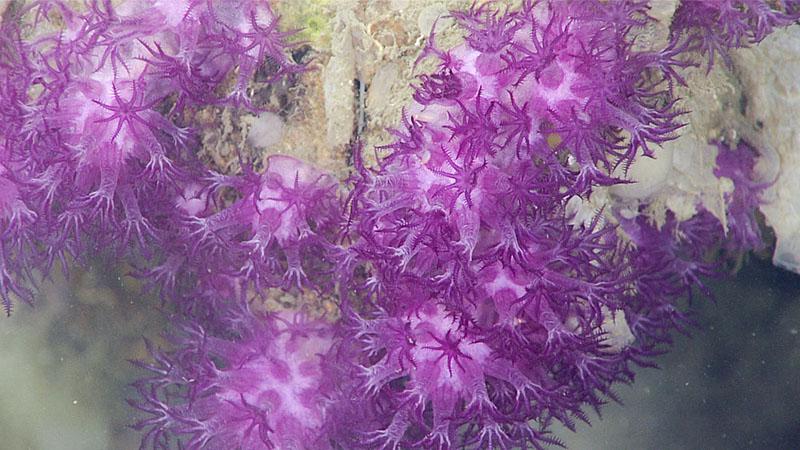
Purple octocoral (Clavularia sp.), seen during Dive 06 of the Deep Connections 2019 expedition. Image courtesy of the NOAA Office of Ocean Exploration and Research, Deep Connections 2019. Download larger version (jpg, 1.5 MB).
Today we had a very special dive that provided the opportunity to both contribute to science and exploration and honor the memory of our colleague, marine spatial ecologist Dr. Brian Kinlan. Dr. Kinlan pioneered the use of habitat suitability models to inform NOAA deep-sea exploration efforts. The models he helped develop informed the selection of many of the dive sites we will explore during the Deep Connections 2019 expedition, including today’s. Our dive site today was within Kinlan Canyon, named after Dr. Kinlan, and we dedicated this dive to his memory, and his friends and family.
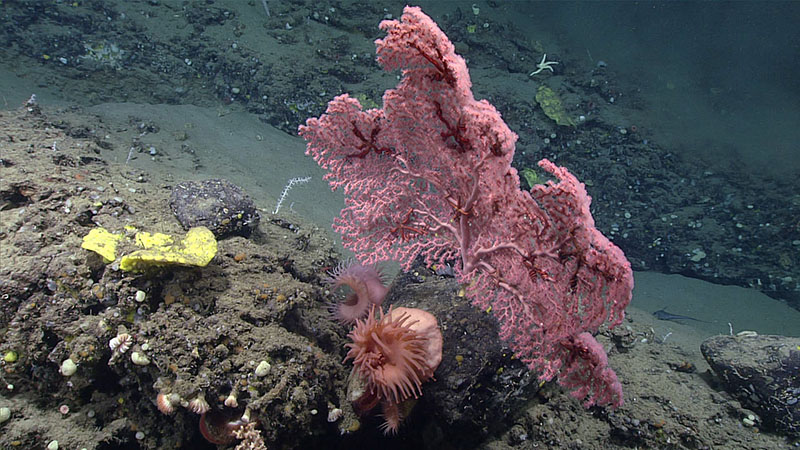
Large bubblegum coral (Paragorgia sp.) with a number of snakestar (Euryalida) associates in its branches, seen during Dive 06 of the Deep Connections 2019 expedition. Image courtesy of the NOAA Office of Ocean Exploration and Research, Deep Connections 2019. Download larger version (jpg, 1.6 MB).
Two previous remotely operated vehicle (ROV) dives have been conducted inside Kinlan Canyon, including one in 2013 by ROV Deep Discoverer and another in 2017 by ROV ROPOS. Both of these dives documented communities of the reef-building coral Lophelia pertusa. Today’s dive sought to further explore the distribution of this and other corals within the canyon, as well of that of sponges and other benthic organisms.
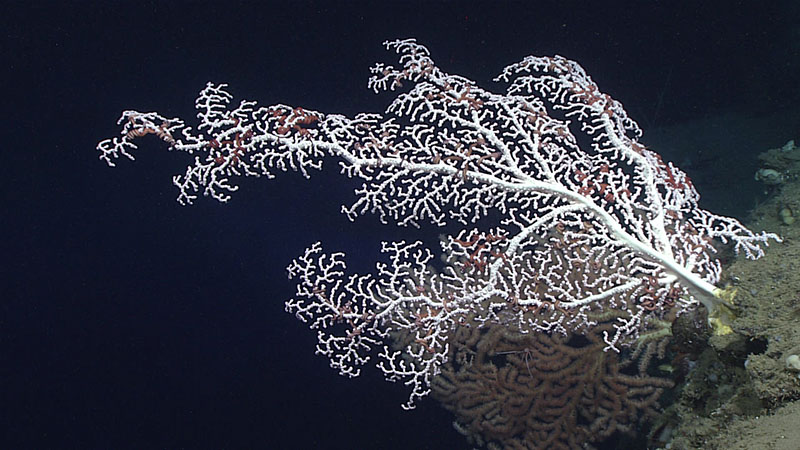
A large bubblegum coral (Paragorgia sp.) seen during Dive 06 of the Deep Connections 2019 expedition. Image courtesy of the NOAA Office of Ocean Exploration and Research, Deep Connections 2019. Download larger version (jpg, 1.3 MB).

Two cutthroat eels (Synaphobranchus gracilis), top and center, struggle over a piece of short-finned squid, as seen during Dive 06 of the Deep Connections 2019 expedition. Image courtesy of the NOAA Office of Ocean Exploration and Research, Deep Connections 2019. Download larger version (jpg, 988 KB).
The ROV reached reached the seafloor on soft substrate in the axis of the canyon at a depth of 1,074 meters (3,526 feet). Cutthroat eels, long-finned hake, spiny lobster, short-finned squid, red crabs, and pancake urchins were documented here. The ROV then began transiting northwards across the canyon axis towards the canyon wall. Once we reached the northern canyon wall, we adjusted our track to ascend the canyon wall on a ridge arm, rather than a gully. At about 1,060 meters (3,478 feet) depth, the slope transitioned from fine grained sediments to large boulders and cobbles encrusted with corals, sponges, and other invertebrates. Our surroundings then transitioned again, this time into sheer cliff walls of poorly sorted sandstone matrix, likely from the same geological formation that was observed at the base of the minor unnamed canyon on Dive 05. We decided to transit along the canyon walls, so as to stay within the same geological unit and maximize our chances of observing Lophelia pertusa. These walls supported dense aggregations of deep-sea corals and sponges, including stoloniferous octocorals, bamboo corals, bubblegum corals, Lophelia pertusa and other stony corals, demosponges, and glass sponges.
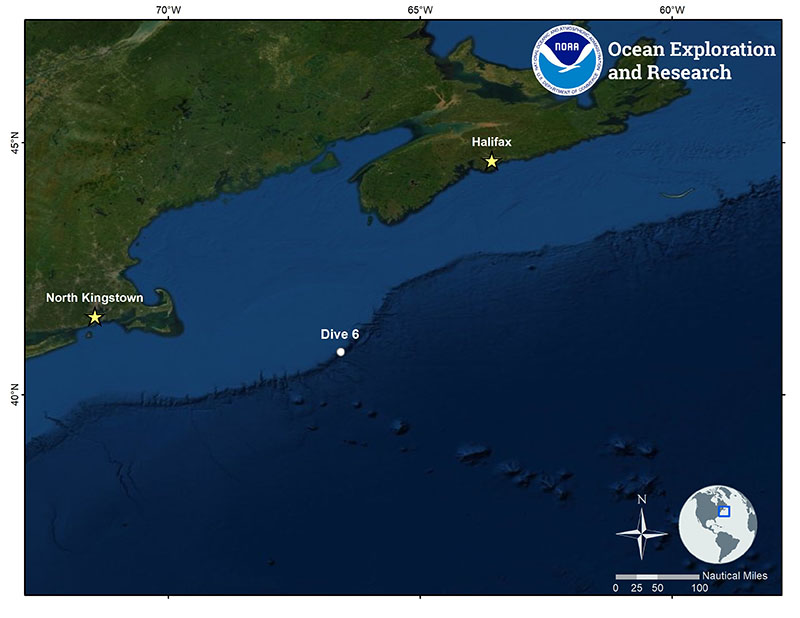
Location of Dive 06 of the Deep Connections 2019 expedition on September 3, 2019. Download larger version (jpg, 1.7 MB).
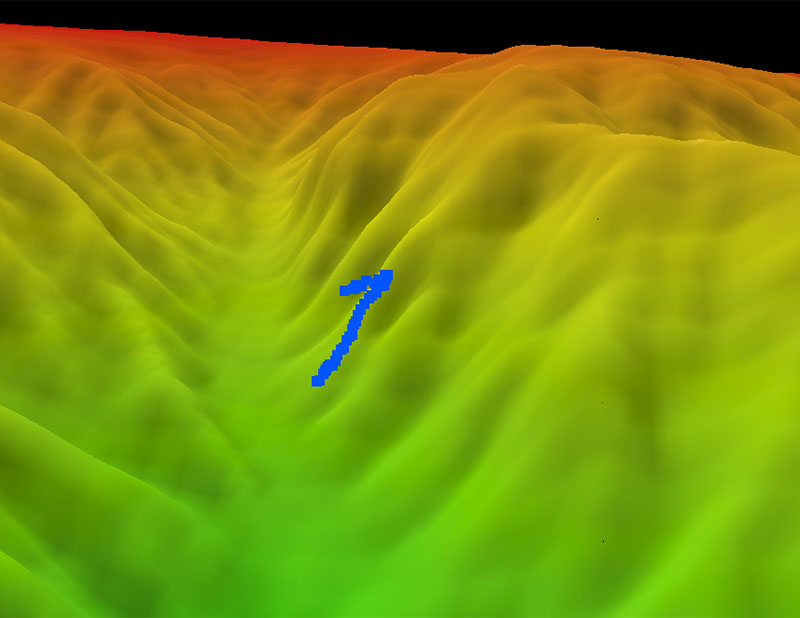
Map showing the dive track of Dive 06 of the Deep Connections 2019 expedition. Scale is water depth in meters. Download larger version (jpg, 320 KB).